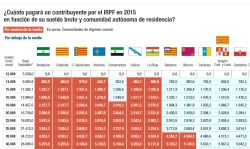
How much will you pay with the new personal income tax according to the community where you live
The last one, Madrid, which announced last Thursday that it is going to lower the Income Tax again by creating a new minimum rate of 9.5% – 19.5% if the state section is included – thus returning to the podium in the ranking of the autonomies with the lowest taxation, which it now shares for low incomes with the Balearic Islands, Cantabria, Asturias and Castilla-La Mancha. Since last September, Castilla-La Mancha, Extremadura, Castilla y León, Valencian Community, Cantabria, Balearic Islands, Aragon, Murcia, Canary Islands, Asturias and Madrid have made public their plans to reduce personal income tax in 2015.
However, not all announcements move in the same direction, since although some regions launch important reductions for all taxpayers, others reduce the tax burden for low incomes but raise it to medium and high incomes and there are those who launch testimonial reductions.
All in all, there are eleven regions of the common regime that are going to lower personal income tax in 2015 (Navarra also foresees reductions) and not all of them fully adapt to the state reform, according to the announcements and the processing of their 2015 Budget Law projects. carried out so far. In fact, Andalusia and Catalonia do not make any changes, which reduces the impact of the state tax reform, which in personal income tax has taken into account the effect of the autonomies replicating the decrease in the autonomous section. However, this change will not be perceived by taxpayers in 2015, since only the regional measures are noted when making the declaration, which will take place in spring 2016. Citizens will instead see the state reduction, which will impact withholdings since January.
The Treasury has stressed that 20 million taxpayers will notice relief in their pockets in January 2015, an election year, in which the effect will be greater on very low and very high incomes. The overall reduction in Income Tax will be an average of 12.5%. The economic report that accompanies the reform details that the reduction in personal income tax will have a final tax collection impact of 4,520 million, compared to the gross 5,981 million that the Government foresees. These figures will be lower due to the lack of complete implementation by the communities.
Madrid. The Community of Madrid has just announced a reduction in the lowest personal income tax rate of 1.7 points, placing this marginal rate at 9.5% for the first 12,450 euros of income, the lowest in Spain along with four other communities. , section through which all income passes. This reduction is added to the one already made by the region chaired by Ignacio González for 2014. In addition, Madrid maintains the lowest maximum marginal, of 21%, of 44.5% if the state section is taken into account.
Balearics. The region chaired by José Ramón Bauzá threatened to announce a tax reduction in July, but budgetary constraints did not seem to allow it. However, in autumn came the announcement of a reduction in personal income tax for medium and low incomes of up to 3.75 points, placing its marginal minimum at 9.5% and the maximum at 21.5%.
Estremadura. The president of Extremadura, José Antonio Monago, finalized in September the tax reduction announced since July: in 2015 the personal income tax for low and medium incomes will be lowered by an average of 15% and will be adapted to the state reform, which will affect the public coffers 81.3 million, and will lower the lowest rate to 10.50%. This decrease will be offset by an increase in personal income tax of up to two points for incomes of 60,000 euros or more, which places the marginal maximum at 25%, only behind Catalonia, Andalusia and Asturias, with 25.5%.
Asturias. As announced by President Javier Fernández, the Principality will divide its first tax bracket next year, so that the first 10,000 euros will go from being taxed at 12% to 11%. This means a reduction of 124 euros for all taxpayers who exceed that figure. However, the region continues to maintain the highest marginal rates, at 25.5%.
Cantabria. The community chaired by Ignacio Diego has been one of those that has taken the tax reduction with the most ambition. On the one hand, the minimum rate is at 9.5%, the lowest in Spain, while intermediate rates are reduced by up to 3.5 points in some income levels, thanks to the fact that the number of sections is reduced from 8 to 5. The community is also the one that reduces taxes on high incomes the most, up to two points from 120,000 euros.
Canary Islands. The islands apply a strong discount for the lowest incomes, who will be able to earn up to 311 euros per year. However, these advantages begin to be diluted after 53,400 euros of annual income. Those who earn more than 90,000 euros will see their marginal rate rise by 1.4 points, to 24% in the regional rate, and they will be the ones to cover the benefits of low and medium incomes.
Castilla la Mancha. The community chaired by María Dolores de Cospedal was the one that opened the melon of tax reductions, betting on a strong reduction for the lowest incomes (also up to 9.5%), combined with a simplification of the sections, equating them with the of the country as a whole. Again, La Mancha also compensates for tax cuts for the vast majority with increases for those with higher incomes, although milder than those in the Canary Islands. In addition, it also increases by 5% from the minimum that is deducted per descendant.
Castilla y León. The region creates a new tranche for the first 10,000 euros of income in which the rate falls to 10%. This represents a reduction in the tax bill of 249 euros per year, for all people who exceed that 10,000 euros of income per year. Furthermore, this is combined with an increase in the exempt minimums, both personal and family, and the softening of the health cent, from 4.8 cents per liter to 1.6.
Catalonia. The community maintains the greatest punishment for the highest incomes, with regional rates reaching 25.5%. With this, personal income tax taxes remain at the highest level in Spain. Furthermore, no corrections are introduced regarding the exempt minimums or deductions for families, as other regions have done.
Andalusia. Something similar happens with Andalusia, since it does not modify its rates, which remain among the highest along with Catalonia, and also maintains the highest section at 25.5%, like Catalonia. In fact, the regional Parliament rejected the tax reform proposed by the PP, which would lower personal income tax to a range between 10% and 24.5%. The opposition proposed a battery of deductions that have also been rejected.
Galicia. In the same way, the region has not lowered its rates either, although in 2014 these were among the lowest in Spain, since President Feijóo declared that he had "gotten ahead." However, Galicia falls to the intermediate zone in the tax pressure ranking, although slightly above the average, with a minimum rate of 11.5%. This lowest marginal has fine print, since it will be 12% for the rest of the incomes when they go through the first section.
The Rioja. Something similar happens in La Rioja, one of those with the lowest tax rates in 2014, which does not plan to make changes, so it remains slightly above the reduction of the state reform in 2015.
Valencian Community. Despite the difficulties in reducing the deficit that the Valencian Community has, the region has announced a reduction in personal income tax of between 0.02 and 0.10 points in 2015. The minimum marginal is 11.90%, and the maximum, at 23,48%.
Murcia. This region is the only one that has followed the state reform in terms of tranches and rates, which will go from seven to five tranches in 2015, with the minimum rate of 10% in 2015, and the maximum of 23.5%. In addition, the provincial surcharge on IAE fees is reduced from 25% to 20%.
Aragon. The community chaired by Luisa Fernanda Rudi will have a minimum rate of 10% and a maximum of 21.5% in 2015. The region increases the family minimums and raises the Inheritance Tax bonus from 50% to 65%.
Fountain: www.expansion.com



